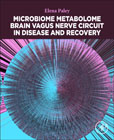
Microbiome Metabolome Brain Vagus Nerve Circuit in Disease and Recovery
Paley, Elena L.
Microbiome Metabolome Brain Vagus Nerve Circuit in Disease and Recovery focuses on the emerging hypothesis of a dysfunctional microbiome - metabolome - vagus nerve - brain circuit in Alzheimer's disease and associated diseases and medical conditions, including dementia, aging, COVID-19, and in autoimmune conditions, including rosacea. The book discusses vagus nerve-related conditions, including Arnold's reflex, laryngopharyngeal reflux, duodenogastric reflux, gastroesophageal reflux, and related pulmonary diseases. Subjects covered address which one is more important for human health and intellectual abilities: the human genome or human microbiome? The conceptual model of food and gut microbial tryptamine - vagus nerve circuit is also presented. Addresses the emerging hypothesis of a dysfunctional microbiome - vagus nerve - brain circuit in Alzheimer's disease and associated diseases and medical conditions Covers dementia, aging, COVID-19, and autoimmune conditions, including rosacea Presents the conceptual model of food and gut microbial tryptamine - vagus nerve circuit Includes discussions on human health and intellectual abilities in the context of both the human genome and the human microbiome INDICE: 1. Introduction: microbial metabolite interference of protein biosynthesis in neurodegenerative and other diseases 2. COVID-19: Scientific Progress 3. Viral-bacterial interactions in diseases 4. Acid reflux, Parietal cells, Vagus nerve, Carpal tunnel syndrome, Alzheimer's disease, COVID-19 and associated medical conditions 5. Vagus nerve circuit: microbiome - tryptophan metabolites - receptors and synapses 6. Glutamate, glutamate receptors in vagus nerve pathways and in Alzheimer's disease 7. Aminoacyl tRNA synthetase multiple forms in autoimmune and infectious diseases 8. Crystalized aromatic L-amino acid decarboxylase from bacteria Micrococcus percitreus catalyzing decarboxylation of tryptophan and L-DOPA (Levodopa or 3,4-dihydroxy-L-phenylalanine) 9. Health effects of elevated CO2 levels, sparkling mineral water, Seltzer carbonated water 10. Microbial antigens, allergies and antibodies to microbial allergens: significance of pre-existing antibodies for vaccination 11. Smell and Taste Identification Deficits in Disease 12. Microorganisms producing biogenic amines: from food to human body 13. Human genome or human microbiome genes: which one is more important for human health and intellectual abilities? 14. Microorganisms used in agriculture, consumed from environment and associated with the edible raw fruits, vegetables, herbs, sprouts, and mushrooms 15. Biogenic amines in aggregation: self-aggregation, protein aggregation, aggregation of platelets and aggregation of microbial pathogens 16. Colonic diverticular disease as a risk factor for neurodegenerative and associated diseases 17. Alzheimer's disease, Dementia, Aging and COVID-19 18. Existing vaccines and new tools 19. Serotonin syndrome in neurodegenerative diseases and COVID-19: mechanisms and consequences of intestinal infection 20. Circulating cell-free mitochondria in blood, a source of monoamine oxidases 21. Protein synthesis inhibition in neuronal activities: axonal transport, memory consolidation, neurite outgrowth 22. Rosacea and associated medical disorders
- ISBN: 978-0-443-19122-0
- Editorial: Academic Press
- Encuadernacion: Rústica
- Páginas: 450
- Fecha Publicación: 01/12/2022
- Nº Volúmenes: 1
- Idioma: Inglés
